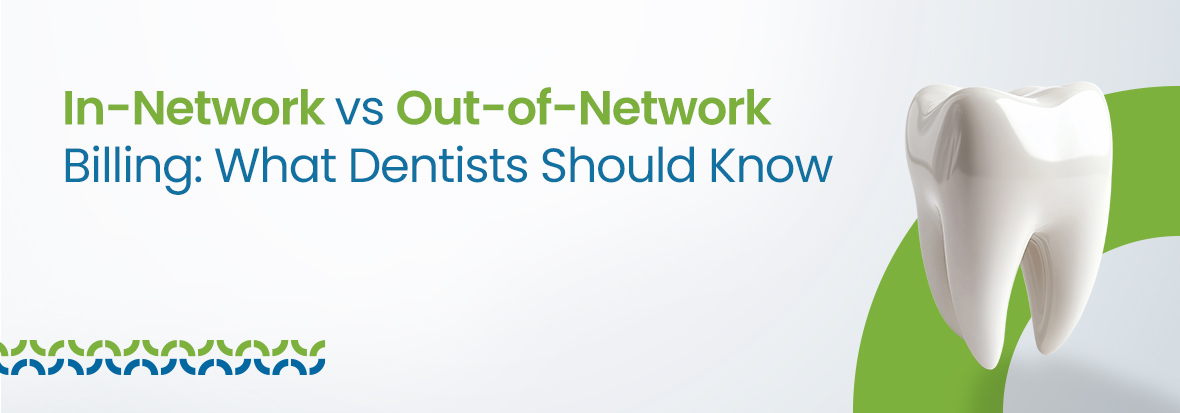Running a dental practice involves understanding network participation options. With profit margins averaging 35-40% and operational complexities increasing, the in network vs out of network decision affects revenue structure, operational workflows, and patient relationships.
This in network vs out of network dental billing guide examines both approaches, exploring what each means for practice revenue, operations, and compliance requirements. You’ll learn about the operational requirements, regulatory considerations, and implementation factors involved in each model.
What Being In-Network Really Means?
Becoming an in network dentist involves signing contracts with insurance companies to accept their fee schedules. These contracts typically pay 50-60% of standard fees in exchange for patient referrals through provider directories. In network dental insurance, processing follows standardized procedures with predetermined reimbursement rates.
When a treatment costs $1,200 at standard rates, network contracts might pay $600-$720. The patient pays their copay according to their plan terms, and the insurance company processes the remaining payment. This creates predictable revenue patterns with standardized administrative processes.
Struggling with verifying patient eligibility for each appointment?
How Out-of-Network Practice Works?
Operating as an out-of-network dentist means setting your own fees and customizing your dental insurance billing services to fit your practice model. You operate without insurance contract restrictions, establishing rates based on your practice costs and service levels. Patients pay your full fee, then submit claims to receive reimbursement from their out of network dental insurance benefits according to their plan terms.
This approach involves different administrative processes, requiring upfront payment collection and patient education about insurance reimbursement procedures. You maintain complete control over fees and treatment protocols without contractual limitations.
The True Financial Impact of Each Network
Network participation decisions affect your practice through different revenue structures, collection processes, and administrative requirements. Both models present distinct financial considerations that require alignment with your dental billing services strategy.
Breaking Down Network Discounts
The difference between in network vs out of network becomes apparent when examining revenue calculations. A practice producing $1.5 million annually at standard fees collects $900,000 through network contracts, reflecting the contracted rate structure.
Network participation typically involves higher patient volume to achieve target revenue levels. Many practices see 20-25 patients daily compared to 12-15 under standard fee models. This volume approach requires specific systems and staff coordination.
Managing Out-of-Network Revenue
Out-of-network practices work with full fee schedules while handling different collection processes and patient communication requirements. Dental out-of-network reimbursement varies by insurance plan, with practices collecting fees upfront and patients receiving reimbursement based on their plan terms.
These practices often see different patient volumes while working toward revenue targets. The fee structure allows different time allocations per patient, which affects treatment planning approaches and service delivery methods.
Operational Realities of In Network vs Out of Network
In network vs out of network practices require different operational approaches, staffing strategies, and administrative systems. Each model presents specific requirements that affect daily workflows and staff responsibilities.
In-Network Operations Management
In-network practices work with standardized administrative processes. Electronic claims follow established procedures, eligibility verification uses predetermined protocols, and payments arrive according to contract terms. Administrative staff work with predictable insurance verification since contracted benefits follow established guidelines.
Operations focus on efficiency within contracted fee structures. Practices develop systems where clinical and administrative staff coordinate patient flow, appointment scheduling, and treatment delivery within the established framework.
Out-of-Network Operations Management
Out-of-network practices require comprehensive financial management systems and staff trained in patient communication and payment coordination. Teams handle upfront payment collection, insurance benefit estimation, and patient financing options as standard procedures.
Out-of-network dentist cost discussions become part of treatment planning conversations, requiring staff training in patient communication and financial coordination. Payment processing systems, treatment planning tools, and patient communication platforms support these operational requirements.
Want to improve cash flow without increasing patient volume?
Compliance and Legal Considerations
Federal and state regulations establish requirements for both network models, affecting billing practices, patient communication standards, and administrative procedures. Understanding these regulatory requirements ensures proper compliance regardless of your chosen approach.
Federal Requirements
Dental practices operate under specific regulations regardless of network status. The No Surprises Act exempts dental practices from certain balance billing restrictions affecting medical providers, though Good Faith Estimates remain required for uninsured patients. Documentation standards apply consistently across both operational models.
In network dentist practices, dentists must follow contracted fee agreements and cannot bill patients for fee differences beyond contract terms. Out-of-network dentists collect full fees, with patients handling insurance reimbursement according to their plan terms. Both approaches require clear patient communication about billing procedures.
State-Specific Regulations
State legislation continues evolving around network participation. Kansas and Kentucky have implemented network leasing transparency requirements. Multiple states have established virtual credit card fee regulations. Thirty-one states currently have protections regarding discounts on non-covered services.
These regulatory changes occur often and directly influence how dental insurance billing services are administered within each network model. Staying current with state requirements helps maintain compliance and understand operational requirements under both approaches.
Reimbursement Based on UCR
Out-of-network insurance payments follow Usual, Customary, and Reasonable benchmarks established by insurance companies. When providers charge $1,200 for a procedure, insurance companies apply UCR calculations that may result in lower reimbursement amounts for patients based on their geographic area.
This requires patient education about insurance reimbursement processes. Patients need to understand how their insurance calculates reimbursements and what their out-of-pocket responsibilities will be under their specific plan terms.
Strategic Decision-Making Framework
The In network vs out of network Billing choice depends on your practice situation, market conditions, and operational capabilities. Both approaches require a systematic analysis of current performance, market factors, and available resources for implementation.
Comprehensive Practice Assessment
Evaluate key metrics, including collection rates, overhead percentages, and profit margins across different procedures. Assess operational capacity through patient volume analysis, staff efficiency evaluation, and technology system capabilities. Analyze local market conditions, including competition, patient demographics, and insurance plan distribution.
These assessment factors help determine which operational model aligns with your practice’s current situation and objectives.
Future-Proofing Your Practice
Insurance industry trends continue to affect both network models through changing reimbursement structures and administrative requirements. Market consolidation influences negotiating dynamics, affecting how both network and non-network practices operate.
Both operational models require technology integration and expert dental billing services to keep up with payer shifts and reimbursement changes. Digital systems, automated processes, and patient engagement platforms support operational requirements regardless of network participation status.
Conclusion
The in network vs out of network decision affects your practice’s operational structure, revenue processes, and patient relationships. Network participation involves standardized procedures and predictable administrative workflows, while out-of-network operations involve fee control and billing processes.
Both approaches require proper analysis, systematic implementation, and ongoing operational management. The choice depends on aligning the approach with your practice situation, then implementing that choice with appropriate expertise and operational attention to detail.

